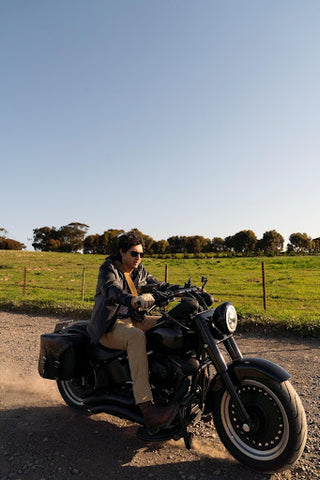Moving on to the amazing journey of motorcycle ownership involves more than just choosing the sleekest model or the most powerful engine.
One of the most important aspects often overlooked is motorcycle ergonomics — the science of optimizing rider posture and comfort for enhanced performance and safety.
As the wind rushes past and the open road beckons, a unique relevance between man and machine exists on two wheels. However, this amazing experience can quickly turn into discomfort and fatigue if the ergonomics are not properly aligned with your body.
They are starting with the world of riding ergonomics – where small adjustments can make a monumental difference in your riding experience.
Studies have shown that proper ergonomic design can expressively reduce the risk of fatigue, discomfort, and even injury during long rides.
According to a report by the Motorcycle Industry Council, over 70% of motorcycle accidents involve riders who have been riding for less than five months, highlighting the importance of rider comfort and control, both of which are heavily influenced by ergonomic factors.
In this blog post, we research the significance of perfecting your ride by understanding and implementing optimal ergonomics. Explore how these can enhance both comfort and performance on the road, ensuring that every journey is a smooth and enjoyable one for riders of all levels.
Motorcycle Ergonomics explained
Motorcycle ergonomics is the science of designing and optimizing the physical interface between a rider and their motorcycle. It consists of the arrangement of various components such as the handlebars, seat, foot pegs, and controls to ensure maximum comfort, control, and safety for the rider.
The importance of this cannot be overstated, as it directly affects rider comfort, confidence, and, ultimately, their enjoyment of the ride. A well-designed ergonomic layout can reduce fatigue during long journeys, minimize the risk of injury by promoting proper posture and weight distribution, and enhance maneuverability and control in different riding conditions.
By prioritizing ergonomics, riders can optimize their comfort and performance and the full potential of their two-wheeled adventures.
The Rider Triangle
At the core of ergonomics lies the concept of the "Rider triangle," a fundamental principle that governs the relationship between the rider's body, the motorcycle, and the riding environment. The rider triangle refers to the geometric arrangement formed by three key points:
- The seat
- The foot pegs
- The handlebars
This triangular configuration directly influences rider comfort, control, and overall riding dynamics.
Adjusting Your Ride
Adjusting your motorcycle's handlebars, seat height, and footpeg placement is crucial for achieving optimal ergonomics and ensuring a comfortable and controlled riding experience.
Here are some tips to help you fine-tune these components:
Seats:
- The seat serves as the foundation of the rider triangle, providing support and stability for the rider's weight.
- The seat needs to distribute pressure evenly to prevent discomfort and fatigue during long rides.
- The height and shape of the seat also impact the rider's ability to reach the foot pegs and handlebars comfortably.
Foot Pegs:
- The foot pegs are positioned to support the rider's feet and legs, allowing them to maintain balance and control while riding.
- Proper footpeg placement ensures that the rider can reach the ground easily when stopped and provides leverage for shifting body weight during cornering and maneuvering.
Handlebars:
- The handlebars act as the main point of contact between the rider and the motorcycle's steering system.
- Their height, width, and angle influence the rider's posture and arm position, affecting comfort and control.
- Adjusting the handlebars can fine-tune the rider's riding position to reduce strain on the arms, shoulders, and back.
Special Tips:
- Remember to adjust gradually and test-ride your motorcycle after each change to assess its impact on comfort and control.
- Additionally, consult your motorcycle's owner's manual or a professional mechanic for guidance on adjusting safely and effectively.
- By fine-tuning the handlebars, seats, and foot pegs to suit your body and riding style, you can enhance your overall riding experience and enjoy greater comfort and control on the road.
Together, the seat, foot pegs, and handlebars form a balanced and ergonomic rider triangle that optimizes comfort and control. By fine-tuning the positioning of these key components, riders can customize their riding experience to suit their individual preferences and riding styles.
Ergonomic Accessories and Modifications
Enhancing riding ergonomics through aftermarket products can significantly improve comfort, control, and overall enjoyment on your motorcycle.
Here's a guide on some popular ergonomic accessories and modifications:
Gel Seat Pads and Cushions:
- Gel seat pads or cushions can be added to your existing motorcycle seat to provide extra cushioning and support, reducing pressure points and fatigue during long rides.
- They come in various shapes and sizes to fit different motorcycle seats and rider preferences.
Windshields and Fairings:
- Windshields and fairings can reduce wind buffeting and fatigue by redirecting airflow away from the rider, particularly at higher speeds.
- They provide added protection from the elements and create a more comfortable riding environment, especially during long highway rides.

Throttle Assist Devices:
- Throttle assist devices, such as cruise control or cramp buster, help reduce hand and wrist fatigue on extended rides by allowing you to maintain a consistent throttle position without constant grip pressure.
- They can enhance comfort during long stretches of highway riding by relieving strain on the throttle hand.
Adjustable Levers:
- Adjustable brake and clutch levers allow you to customize the reach and angle of your controls to accommodate different hand sizes and preferences.
- They provide a more ergonomic and comfortable grip, reducing hand fatigue and improving control.
Extra Tips:
- When considering aftermarket ergonomic accessories and modifications, it's essential to choose premium quality products that are well-matched with your motorcycle model and meet safety standards.
- Additionally, consult with experienced riders or professionals for recommendations and installation advice to ensure proper fitment and functionality.
By investing in ergonomic upgrades tailored to your needs, you can enjoy a more comfortable, controlled, and enjoyable riding experience on your motorcycle.
Impact of Ergonomics on Riding Experience

Proper ergonomics plays a vital role in shaping the riding experience, especially during long journeys, and has a significant impact on rider fatigue.
Here's a discussion on how proper ergonomics affects long rides and rider fatigue:
Comfortable Riding Position:
Proper ergonomics ensure that the rider is positioned comfortably on the motorcycle, with minimal strain on their body. A well-fitted seat, Adjustability of handlebars, and footpeg placement at the right height all contribute to maintaining a natural riding posture.
Reduced Fatigue:
Optimal ergonomics help distribute the rider's weight evenly across the motorcycle, reducing fatigue during long rides.
By minimizing the physical strain on the body, riders can maintain focus and concentration for extended periods without experiencing excessive tiredness. Properly positioned controls, such as adjustable handlebars and footpegs, allow riders to relax their arms and legs, reducing muscle fatigue and resulting in better blood circulation.
Increased Riding Enjoyment:
Proper ergonomics ultimately lead to a more enjoyable riding experience. When riders are comfortable and free from fatigue, they can fully immerse themselves in the journey, appreciating the scenery and enjoying the thrill of the ride.
By investing in ergonomic enhancements and adjustments tailored to their specific needs, riders can personalize their riding experience and extract maximum enjoyment from every mile traveled.
In short, proper ergonomics significantly impacts the riding experience, particularly during long rides, by promoting comfort, reducing fatigue, enhancing control and stability, and ultimately increasing riding enjoyment.
Conclusion
Motorcycle ergonomics is a critical aspect of the riding experience that directly influences comfort, control, and overall enjoyment on the road. Proper ergonomics promote a comfortable riding position, reduce fatigue, enhance control and stability, and ultimately increase riding enjoyment.
We encourage all riders to take the time to evaluate their motorcycle's ergonomics and make necessary adjustments to achieve optimal comfort and control. Whether it's Adjustability of the handlebar height, adding a gel seat pad, or installing adjustable footpegs, small changes can make a big difference in the riding experience.
So, let's hit the road with confidence, knowing that our motorcycles are perfectly tailored to provide us with the best riding experience possible.
FAQ
How can I improve my motorcycle ergonomics?
Improving your ergonomics can greatly enhance your riding experience by promoting better comfort, control, and reduced strain. Some ways to do this include adjusting the handlebars and seat height to find the perfect riding position, using motorcycle-specific accessories like handlebar grips and backrests, and practicing proper riding techniques such as maintaining good posture and using control to shift weight around. Ensuring these steps can help improve your overall riding efficiency and reduce the risk of discomfort or injury.
What is the ergonomic seating position on a motorcycle?
By adjusting the handlebars and seat height, using accessories like grips and backrests, and practicing proper riding techniques, you can find a comfortable and optimal riding position that reduces strain and promotes control. Taking these steps not only improves your overall riding efficiency but also reduces the risk of discomfort or injury, ensuring that you can ride for miles with joy and safety.
What is the most comfortable motorcycle riding position?
Improving your motorcycle ergonomics is essential for maximizing your riding pleasure and safety. By making adjustments to the handlebars and seat height, utilizing specialized accessories like grips and backrests, and practicing proper riding techniques; you can find a comfortable and optimal riding position that reduces strain and enhances control. Taking these steps not only improves your overall riding efficiency but also reduces the risk of discomfort or injury, allowing you to ride for miles with joy and safety.











